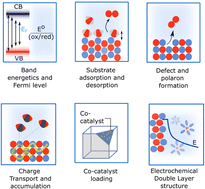The role of crystal facets and disorder on photo-electrosynthesis
Abstract
Photoelectrochemistry has the potential to play a crucial role in the storage of solar energy and the realisation of a circular economy. From a chemical viewpoint, achieving high conversion efficiencies requires subtle control of the catalyst surface and its interaction with the electrolyte. Traditionally, such control has been hard to achieve in the complex multinary oxides used in PEC devices and consequently the mechanisms by which surface exposed facets influence light-driven catalysts are poorly understood. Yet, this understanding is critical to further improve conversion yields and fine-tune reaction selectivities. Here, we review the impact that crystal facets and disorder have on photoelectrochemical reactivity. In particular, we discuss how the crystal orientation influences the energetics of the surface, the existence of defects and the transport of reactive charges, ultimately dictating the PEC activity. Moreover, we evaluate how facet stability dictates the tendency of the solid to undergo reconstructions during catalytic processes and highlight the experimental and computational challenges that must be overcome to characterise the role of the exposed facets and disorder in catalytic performance.

- This article is part of the themed collections: Nanoscale Most Popular 2022 Articles and Recent Review Articles


 Please wait while we load your content...
Please wait while we load your content...